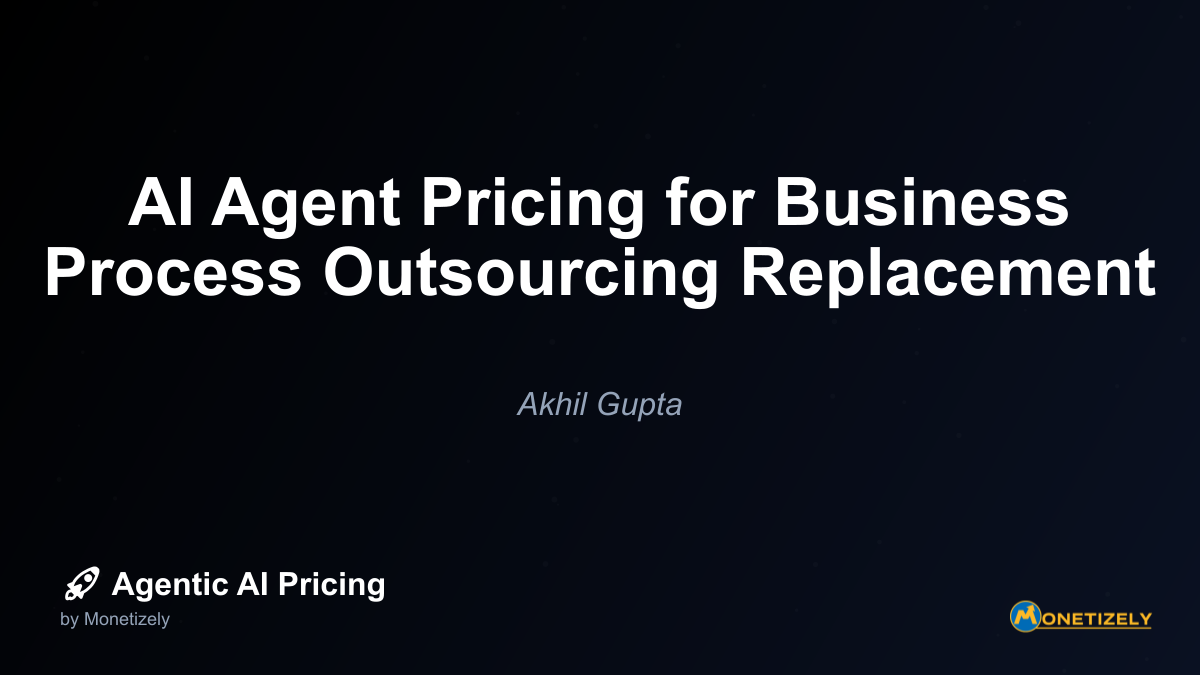· Akhil Gupta · ROI and Value · 11 min read
Quick Wins: Proving AI Value in Pilot Phases.
AI and SaaS Pricing Masterclass
Learn the art of strategic pricing directly from industry experts. Our comprehensive course provides frameworks and methodologies for optimizing your pricing strategy in the evolving AI landscape. Earn a professional certification that can be imported directly to your LinkedIn profile.

Proving the value of AI investments doesn’t always require lengthy implementation cycles or enterprise-wide deployments. In fact, some of the most successful AI adoption strategies begin with small, focused initiatives that deliver immediate results. These “quick wins” during pilot phases can generate the evidence needed to secure further investment while building organizational momentum for more ambitious AI implementations.
Why Quick Wins Matter in AI Pilot Projects
When introducing agentic AI solutions into an organization, stakeholders often face skepticism about return on investment. Decision-makers want evidence that these technologies will deliver tangible benefits before committing significant resources. This creates a challenging dynamic: executives want proof before investment, but meaningful proof requires some level of investment.
Quick wins solve this paradox by focusing initial AI efforts on narrow, high-impact use cases that can demonstrate value rapidly. These targeted implementations serve multiple purposes:
- Risk mitigation - Small-scale pilots limit financial exposure while testing the technology’s capabilities
- Stakeholder buy-in - Early successes build confidence among key decision-makers
- Organizational learning - Teams gain practical experience with AI implementation
- ROI validation - Even modest wins provide concrete data points to justify expanded investment
- Momentum building - Success creates enthusiasm and reduces resistance to change
Research from McKinsey suggests that organizations taking an incremental approach to AI adoption achieve a 50% higher success rate compared to those attempting comprehensive transformations from the outset. The key lies in selecting the right opportunities for these initial pilots.
Identifying the Perfect Quick Win Opportunities
Not all use cases are suitable for quick-win pilot projects. The ideal candidates share several characteristics:
Clear Pain Points with Measurable Impact
The most compelling quick wins address obvious organizational pain points—processes that are visibly inefficient, error-prone, or resource-intensive. When employees and leaders already recognize these challenges, the value of improvement becomes immediately apparent.
For example, a financial services company might target the manual review of routine documentation. If analysts currently spend 15 hours weekly reviewing standard contracts, an AI solution that reduces this to 3 hours creates a quantifiable time savings of 12 hours per analyst per week. This translates to direct cost savings and productivity improvements.
Limited Scope and Complexity
Quick wins should be achievable within a condensed timeframe—typically 30-90 days from initiation to measurable results. This requires selecting use cases with:
- Minimal dependencies on other systems or processes
- Limited stakeholder coordination requirements
- Clearly defined boundaries and objectives
- Reasonable technical complexity
- Accessible data sources
A manufacturing company might choose to implement an AI-powered quality inspection system for a single production line rather than attempting to transform the entire factory floor. This focused approach enables faster implementation and clearer attribution of benefits.
High Visibility Within the Organization
The impact of pilot projects should be visible to key stakeholders and decision-makers. Selecting use cases that affect high-profile business areas or address widely recognized challenges ensures that successes won’t go unnoticed.
A customer service AI implementation might target the top three most frequent customer inquiries, automating responses to reduce resolution times from days to minutes. When customers and service representatives experience this improvement directly, it creates compelling evidence that resonates throughout the organization.
Pricing Considerations for Quick Win Pilots
The financial structure of AI pilot projects requires careful consideration. Traditional ROI calculations may not fully capture the strategic value of these initiatives, as they serve both immediate operational needs and longer-term transformation goals.
Cost-Effective Pilot Pricing Models
When negotiating with AI vendors for pilot implementations, several pricing approaches can help minimize initial investment while maintaining alignment between costs and value:
- Outcome-based pricing - Link payment to achievement of specific performance metrics
- Consumption-based models - Pay only for actual usage or transactions processed
- Phased implementation fees - Structure payments to correspond with delivery milestones
- Trial periods - Negotiate reduced rates during initial evaluation phases
- Risk-sharing arrangements - Establish partnerships where vendors participate in both risk and reward
The key is creating financial structures that allow for meaningful testing without requiring full enterprise-scale investment. This might mean implementing a solution for a single department or business unit rather than company-wide deployment.
Value Calculation Beyond Direct ROI
While direct cost savings and revenue generation remain important, quick wins often deliver additional value that should be captured in assessment frameworks:
- Time compression - Reducing cycle times for key processes
- Error reduction - Minimizing costly mistakes or rework
- Employee satisfaction - Improving workplace experience by eliminating tedious tasks
- Customer experience - Enhancing responsiveness and service quality
- Risk mitigation - Reducing compliance or operational risks
- Data quality improvements - Creating cleaner, more usable information assets
A comprehensive value framework considers these factors alongside traditional financial metrics to provide a holistic view of pilot impact.
Executing Successful Quick Win Pilots
The implementation approach for quick win pilots differs significantly from enterprise-scale AI initiatives. These focused projects require streamlined processes and rapid iteration.
Setting Clear Success Criteria
Before implementation begins, establish specific, measurable success criteria that align with organizational priorities. These might include:
- Percentage reduction in processing time
- Number of errors eliminated
- Volume of transactions automated
- Cost savings achieved
- Customer satisfaction improvements
- Employee time redirected to higher-value activities
For example, a healthcare provider implementing AI for appointment scheduling might target a 40% reduction in no-shows, 25% decrease in scheduling staff time, and 15% improvement in patient satisfaction scores. These concrete metrics create a clear benchmark for success.
Rapid Implementation Approaches
Quick win pilots benefit from agile, iterative implementation methodologies:
- Minimum viable product (MVP) focus - Implement only the core functionality needed to demonstrate value
- Frequent stakeholder feedback - Maintain continuous communication with end-users and decision-makers
- Flexible adaptation - Adjust approach based on early learnings rather than rigid adherence to initial plans
- Parallel workstreams - Conduct technical implementation alongside change management activities
- Simplified governance - Streamline approval processes while maintaining necessary oversight
This approach enables teams to move quickly while maintaining quality and alignment with organizational needs.
Change Management for Quick Wins
Even small-scale AI implementations require thoughtful change management. Employees affected by new technologies need clear communication, appropriate training, and ongoing support. For quick win pilots, focus on:
- Transparent communication about project goals and employee impact
- Hands-on training with the specific AI capabilities being implemented
- Clear guidance on how roles will evolve with AI assistance
- Recognition for team members who embrace and contribute to the new approach
- Regular check-ins to address concerns and gather feedback
When employees understand how AI will make their work more effective rather than threatening their positions, they become powerful advocates for continued adoption.
Documenting and Communicating Success
The ultimate purpose of quick win pilots is building evidence to support expanded AI investment. This requires rigorous documentation and effective communication of results.
Comprehensive Success Measurement
Document both quantitative and qualitative outcomes from pilot implementations:
- Performance metrics - Capture concrete improvements in efficiency, accuracy, and output
- Financial impact - Calculate direct cost savings and revenue enhancements
- User testimonials - Gather feedback from employees and customers affected by the implementation
- Process improvements - Document changes in workflows and procedures
- Unexpected benefits - Note any positive outcomes not anticipated in initial planning
This multi-dimensional assessment provides a robust foundation for evaluating the pilot’s success.
Compelling Success Narratives
Translate technical achievements into business narratives that resonate with different stakeholders:
- For executives: Focus on financial outcomes and strategic alignment
- For department leaders: Emphasize operational improvements and team benefits
- For frontline employees: Highlight how AI enhances rather than replaces their contributions
- For IT teams: Document technical learnings and integration insights
- For customers: Communicate service improvements and experience enhancements
These tailored messages ensure that all stakeholders understand the value proposition in terms relevant to their priorities.
Scaling Strategy Development
Use pilot results to develop a thoughtful strategy for scaling successful implementations:
- Expansion roadmap - Identify logical next steps for broadening implementation
- Resource requirements - Outline the investments needed for expanded deployment
- Risk assessment - Analyze potential challenges in scaling beyond the pilot environment
- Timeline projections - Establish realistic schedules for phased implementation
- Success metrics - Define how value will be measured at larger scale
This forward-looking perspective transforms quick wins from isolated successes into catalysts for broader transformation.
Real-World Examples of AI Quick Wins
Examining successful quick win implementations provides valuable insights for organizations planning their own pilots.
Customer Service Automation
A telecommunications provider implemented an AI chatbot to handle the top five customer inquiries about billing issues. Within 60 days, the solution was:
- Resolving 35% of inquiries without human intervention
- Reducing average resolution time from 24 hours to 10 minutes
- Improving customer satisfaction scores by 22%
- Allowing service representatives to focus on complex issues
This targeted implementation created immediate value while providing a foundation for expanding automation to additional service areas.
Predictive Maintenance in Manufacturing
A mid-sized manufacturer implemented AI-powered predictive maintenance on a critical production line experiencing frequent breakdowns. The 45-day pilot delivered:
- 62% reduction in unplanned downtime
- $157,000 in avoided production losses
- 28% decrease in maintenance costs
- Improved workplace safety through early issue detection
This success led to phased implementation across all production facilities over the following 18 months.
Sales Process Enhancement
A B2B software company deployed an AI tool to analyze sales conversations and recommend effective responses to common objections. The 90-day pilot demonstrated:
- 14% improvement in conversion rates
- 23% reduction in sales cycle length
- More consistent messaging across the sales team
- Enhanced onboarding experience for new sales representatives
These results justified expanding the solution to all customer-facing teams, including account management and customer success.
Common Pitfalls to Avoid in Quick Win Pilots
Even with focused implementation approaches, organizations may encounter challenges that undermine quick win initiatives.
Scope Expansion
Perhaps the most common pitfall is allowing pilot scope to expand beyond its original boundaries. This “scope creep” typically occurs when stakeholders request additional features or integration points during implementation. While these requests may have merit, they can delay completion and obscure the value of the core use case.
Establish clear scope boundaries at project initiation and implement a formal change management process for any proposed expansions. Defer non-critical enhancements to post-pilot phases to maintain focus on quick value delivery.
Unrealistic Expectations
Quick wins can deliver significant value, but unrealistic expectations about implementation timelines or performance improvements may lead to perceived failure even when objective results are positive.
Set conservative targets based on realistic assessments of what can be achieved in the pilot timeframe. When communicating with stakeholders, emphasize that pilots represent initial capabilities that will improve through continued development and refinement.
Insufficient Change Management
Technical implementation alone rarely delivers optimal results. Without appropriate change management, employees may resist new tools or use them ineffectively.
Allocate adequate resources to training, communication, and support activities throughout the pilot process. Identify influential team members who can serve as champions for the new capabilities and address concerns proactively.
Incomplete Value Measurement
Narrowly focused metrics may miss significant portions of the value created by AI implementations. For example, measuring only direct cost savings might overlook improvements in customer experience or risk reduction.
Develop comprehensive measurement frameworks that capture both tangible and intangible benefits. Include leading indicators that can predict longer-term value even during short pilot periods.
Building Momentum from Quick Wins
The true power of quick wins emerges when organizations leverage initial successes to build momentum for broader AI adoption. This requires thoughtful planning beyond individual pilot projects.
Creating an AI Portfolio Approach
Rather than viewing quick wins as isolated initiatives, develop a portfolio of opportunities at different scales and complexity levels. This might include:
- Multiple quick win pilots addressing different business challenges
- Medium-complexity projects building on successful pilots
- Strategic initiatives with longer implementation timelines but transformative potential
This portfolio approach allows organizations to demonstrate continuous progress while pursuing more ambitious long-term goals.
Developing AI Competency Centers
As quick win projects generate interest and demonstrate value, organizations should consider establishing formal structures to support ongoing AI adoption. These might include:
- Centers of excellence with specialized AI expertise
- Cross-functional teams focused on identifying new AI opportunities
- Training programs to develop internal AI capabilities
- Governance frameworks for responsible AI implementation
- Standardized evaluation methodologies for assessing AI initiatives
These structures transform ad hoc pilots into sustainable capabilities that drive continuing innovation.
Creating Virtuous Cycles of Adoption
Successful quick wins create positive feedback loops that accelerate AI adoption:
- Initial success generates enthusiasm and resources for expanded implementation
- Expanded implementation creates additional value and organizational learning
- Learning enables more sophisticated applications and greater benefits
- Greater benefits justify increased investment in AI capabilities
- Increased investment enables more ambitious transformation initiatives
Organizations that recognize and nurture these virtuous cycles can transform isolated quick wins into comprehensive digital transformation.
Conclusion
In the journey toward AI-powered transformation, quick wins provide the essential first steps. By focusing on targeted use cases with immediate value potential, organizations can generate the evidence needed to justify broader investment while building critical capabilities and momentum.
The most successful organizations approach quick wins not as ends in themselves but as strategic building blocks in a larger transformation journey. They select pilot opportunities thoughtfully, implement them efficiently, measure outcomes comprehensively, and use the resulting insights to guide ongoing innovation.
As you consider your organization’s AI strategy, look for these quick win opportunities—the obvious pain points, manual processes, and data-rich decisions that could benefit from intelligent automation. Start small, demonstrate value quickly, and use those successes to build the case for more ambitious transformation. In the rapidly evolving landscape of agentic AI, this approach balances prudent resource management with the imperative for digital innovation.
Co-Founder & COO
Akhil is an Engineering leader with over 16+ years of experience in building, managing and scaling web-scale, high throughput enterprise applications and teams. He has worked with and led technology teams at FabAlley, BuildSupply and Healthians. He is a graduate from Delhi College of Engineering and UC Berkeley certified CTO.
Pricing Strategy Audit
Let our experts analyze your current pricing strategy and identify opportunities for improvement. Our data-driven assessment will help you unlock untapped revenue potential and optimize your AI pricing approach.




